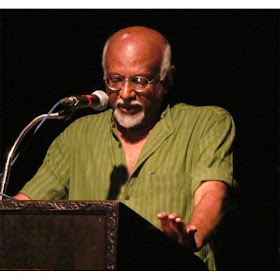It was a
long time desire come true when I met Sanjay Kumar at the launch of his new
book, ‘the Third Squad’ in Chennai. I was so impressed with Sanjay’s first
novel, ‘ Artist, undone’, that ever since, I had always been wanting to meet
him. I had read ‘ Artist , undone’ at a time when I had just started
appreciating art and the art world, thanks to the book ‘ How to be both’ by Ali
Smith and the various shows and art writing workshop held at Apparao galleries.
 |
| Image from Tehelka |
When I met
him and suggested the idea to him, Sanjay gracefully agreed to visit our book
club, that was scheduled to meet the next day and introduce his new book to us. It was
fabulous that he not only sat through but also lent a patient and a keen ear to
the Book club’s deliberations on the month’s book, ‘ Racing in the rain’ and
conveyed his appreciation to the members about how impressed he was with the
depth and quality of the discussion.
Sanjay read
out an introductory note about his new book and third novel, ‘The Third squad’,
which was set in the Mumbai of, what Sanjay calls, ‘ the bloody 90s’. It would
be instructive to know how Sanjay, who was born in Karaikudi, did Graduation in
Loyola, Chennai and was one of the first non-engineering graduates to join IIM
Ahmedabad, fresh out of graduation, for an MBA. Sanjay joined the Financial
capital and had a good run in the Finance industry, that any young management
graduate could dream of. It was Sanjay’s interests in the art world that led
him to establish a gallery in Mumbai, and that him to brush against some of the
worst things the city was going through.
Sanjay recounted
an event, from his early days in Mumbai, when he had arranged for an art show
by four Pakistani women artists and men from the local powers that be,
threatened and almost ended up trying to burn down the gallery. The show had to
be cancelled much against Sanjay’s wish. I believe it is personal brushes such
as this and the larger violence that the
city was subject to that form the inspiration to this book.
Sanjay
recounted how this book started as a short story about two cops and slowly grew
into this novel. It’s about the cops who had to respond to the sudden growth in
rowdyism, kidnapping, extortions etc and the solution had to be quick fire, as
the judicial route proved to be dangerously circuitous.
The extracts
that he read from the book conveyed what an art connoisseur he was. He had an
artistic way of painting the cramped and mundane space of the chawl life. Its
no wonder that an author in the audience called him the poet of cities. Earlier
Sanjay also mentioned that he owed a lot of his writing to his friends from the
art world, who took him under their wings during the initial days.
Another
extract he read from the book, conveyed the mental agony and tension a police
man goes through while facing his family for lunch just after he has returned
from gunning down a target.
While the
book was classified as a Noir, Sanjay was happy that many of his readers found
it to be a gripping Thriller. The book has been published in the US and has had
a good run there. It is no surprise that given the book’s setting in a
turbulent period in the history of Mumbai, It is being made into a Tele picture.
In a casual
chat later with Sanjay, I figured that Sanjay was quite obsessed with the
writings of Naipaul and these days he was mostly hooked to the television with shows
on crime and investigation. Sanjay is interested in writing about the dark
things in life that are often swept under the carpet. While I kept insisting that
he write a memoir, recounting how he juggled his way up to success in Finance
and the art world, Sanjay did not show any interest. His writer instincts were
eagerly observing the present volatile political scenario in Tamil nadu about
which he is itching to write his next novel.
i figured from my chat with Sanjay, that he is
not someone who stakes too much in research. He does the basic ground work and
lets his imagination do the rest. His novels are based in Chennai or Mumbai or
both. Now that he has been living in Bangalore for the past two years and has
developed a liking for golf, one can expect these to feature in his forthcoming
novels.




